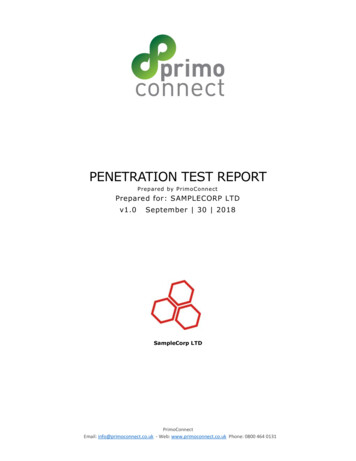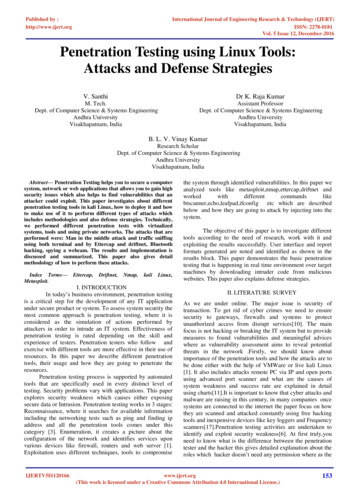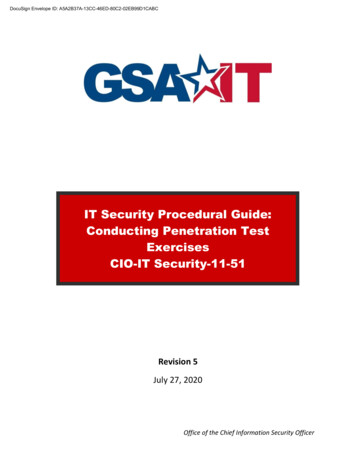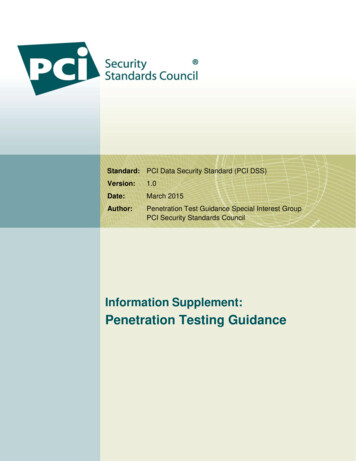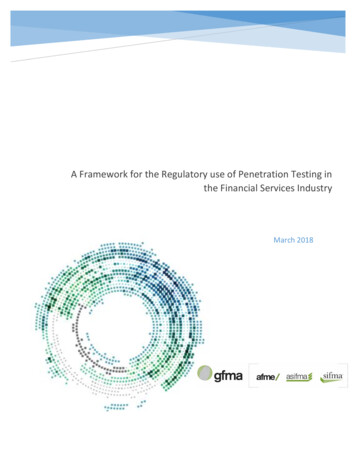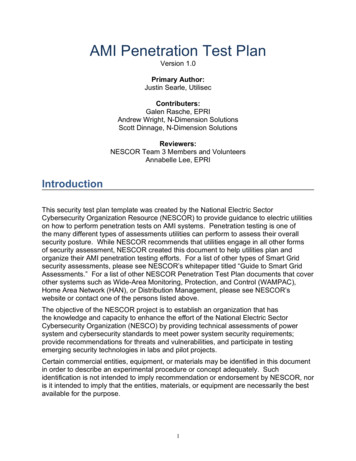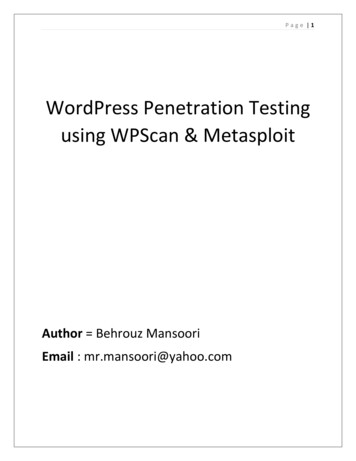
Transcription
Page 1WordPress Penetration Testingusing WPScan & MetasploitAuthor Behrouz MansooriEmail : mr.mansoori@yahoo.com
Page 2In this tutorial, I will show you how to use WPScan and Metasploit to hack a WordPress websiteeasily. You will learn how to scan WordPress sites for potential vulnerabilities, take advantage ofvulnerabilities to own the victim, enumerate WordPress users, brute force WordPress accounts,and upload the infamous meterpreter shell on the target’s system using Metasploit Framework.In short, I will explain very well the following: How To Use WPScan To Find Vulnerabilities To Exploit Effectively How To Critically Think And Examine Potential Vulnerabilities How To Take Advantage Of The Vulnerabilities Disclosed By WPScan How To Enumerate WordPress Users/Accounts How To Brute Force The WordPress Admin Account Password How To Use Metasploit To Exploit A Critical Plugin Vulnerability Discovered ByWPScan How To Use A Payload In Metasploit To Exploit WordPressOpen WPScanYou can open up a terminal and type in wpscan or go to Applications Web ApplicationAnalysis WPScan
Page 3Update Your WPScan’s Vulnerabilities Database.The first thing to do before is ensuring that your WPScan’s vulnerabilities database is up-to-date.Type the subsequent command into terminal to update the database:wpscan --updateIf you have this problemWe will enter another commandwpscan --update --verbose
Page 4
Page 5Start Scanning Website For WordPress/Plugins/Themes VulnerabilitiesType the subsequent command into terminal to scan the target’s website for potentiallyexploitable vulnerabilities:wpscan —url targetwordpressurl.com
Page 6
Page 7As we can see, WPScan has discovered various facts about the target’s website including and notlimited to: XMLRPC.php (XML-RPC Interface) is open for exploitation like brute-forcing andDDoS pingbacks. WordPress core version is identified: 2.0.1 15 WordPress core vulnerability:owp-register.php Multiple Parameter XSSoadmin.php Module Configuration Security BypassoXMLRPC Pingback API Internal/External Port ScanningoXMLRPC pingback additional issuesowp-includes/comment.php Bypass Spam RestrictionsoMultiple Cross-Site Scripting (XSS) in request filesystem credentials()oCross-Site Scripting (XSS) in wp-admin/plugins.phpowp-includes/capabilities.php Remote Authenticated Administrator DeleteAction BypassoRemote Authenticated Administrator Add Action BypassoLong Password Denial of Service (DoS)
Page 8 oServer Side Request Forgery (SSRF)oPost via Email Checks mail.example.com by DefaultoRSS and Atom Feed EscapingoApplication Denial of Service (DoS) (unpatched)oAuthenticated Arbitrary File DeletionWordPress theme and version used identified.The Red ! sign refers to a specific component of a site being vulnerable to exploitation.
Page 9As WPScan reveals that the site has: Vulnerable Contact Form with a Security Bypass, File Upload RCE Available(References: WPVulnDB, SecurityFocus, CVE MITRE, PacketStormSecurity) Vulnerable LAyerSlider with a Style Editing CSRF, Remote Path Traversal FileAccess, CSRF / Authenticated Stored XSS & SQL Injection Available (References:WPVulnDB,PacketStormSecurity, secunia, wphutte)It’s important to note that even when WPScan cannot determine a version of a specific plugin, itwill print out a list of all potential vulnerabilities. It is beneficial to take the time to review, visitthe reference sites individually, and execute these exploits to determine whether the target site isvulnerable to them or not. Just because a plugin version cannot be determined does not mean thesite is not vulnerable.
P a g e 10It is beneficial to take the time to review vulnerabilities, visit the reference sites individually, andexecute these exploits to determine whether the target site is vulnerable to them or not. Justbecause a plugin version cannot be determined does not mean the site is not vulnerable.Reference Sites You Should Use To Conduct Research For Potential Vulnerabilities https://wpvulndb.com https://packetstormsecurity.com https://www.exploit-db.com https://cve.mitre.org http://www.securityfocus.com http://cxsecurity.comAn interesting exampleSuppose the result of scanning a site is this way:
P a g e 11The target’s site is vulnerable to two critical Slider Revolution exploits: Local File Inclusion Shell UploadWe can carry out these attacks easily.For example, we can use the Slider Revolution Upload Execute Exploit via Metasploit.Metasploit already has this exploit ready to use for your pleasure.One more thing before we proceed with the Metasploit Framework Tutorial:How To Enumerate WordPress Users/AccountsThe WordPress user/account enumeration tool integrated into WPScan is deployed to obtain alist of registered WordPress users from the target’s website.User enumeration is imperative when a hacker needs to obtain access to a particular target viabrute forcing the target’s WordPress administrator account.The WPScan user enumeration tool will scan the target’s site for WordPress authors andusernames.Deploy the subsequent command to enumerate the WordPress users: wpscan —url targetwordpressurl.com –enumerate u
P a g e 12As we can see, WPScan’s User Enumeration Tool identified: Two user accounts, particularly the most important: admin (Default admin name leftunchanged) admin is still used. Second account may possess admin privileges, can brute force both simultaneously if required.How To Brute Force The WordPress Admin Account PasswordType the subsequent command into terminal to brute force the password for user admin: wpscan –url targetwordpressurl.com –wordlist /usr/share/wordlists/rockyou.txt (replacewordlist and location with your choice) –username admin (your target’s username) –threads 2(replace the number of threads you would like to use)For a clean version without those annoying brackets I just used, here is the command: wpscan —url targetwordpressurl.com–wordlist /usr/share/wordlists/rockyou.txt –usernameadmin –threads 2Eventually, you could see the password listed in terminal beside the login ID.
P a g e 13Launch Metasploit Framework Via Your Linux Distro DesktopFYI, even though this RevSlider plugin vulnerability has been patched, many WordPresswebsites out there still haven’t updated their RevSlider plugin, which makes them susceptible togetting owned by 1337 hax0rs.Type In The Subsequent Commands Into Terminal: search revslider use exploit/unix/webapp/wp revslider upload execute show options
P a g e 14You need to set your target’s website URL using the subsequent command:set rhost 127.0.0.1/targetsiteurl.com (Replace IP Address with site’s IP or simply replacetarget’s site URL.)ANDYou need to set your target’s URI base path to their WordPress application using the subsequentcommand:set targeturi /wordpress (Replace /wordpress with individual directory path if WordPress is notinstalled in /)Use A PayloadWe need to set a payload. In our demonstration, we use the notorious meterpreter payload to pwnour target.Type in the subsequent commands in Terminal: set payload php/meterpreter/bind tcp show options
P a g e 15Make sure that rhost for both module and payload options are filled with your target’s site IPaddress/URL.You could check/confirm if the target is vulnerable by typing in “check” command into theterminal.You would get the response message: “The target appears to be vulnerable.” We already knowthat, but just to check again.Now to get the meterpreter shell on the target’s system, simply type in “exploit” command intothe terminal.If successful, the following messages will show in terminal: “127.0.0.1 (Target’s IP Address Replaced) – Our payload is at “ “127.0.0.1 (Target’s IP Address Replaced) – Calling payload “ “Deleted oCDNSJ.php“
P a g e 16 “Deleted ./revslider.zip“I hope the training is usefulmr.mansoori@yahoo.comInstagram.com/Behrouz mansoori
How To Enumerate WordPress Users/Accounts How To Brute Force The WordPress Admin Account Password How To Use Metasploit To Exploit A Critical Plugin Vulnerability Discovered By WPScan How To Use A Payload In Metasploit To Exploit WordPress Open WPScan You can open up a terminal and type in wpscan or



